-
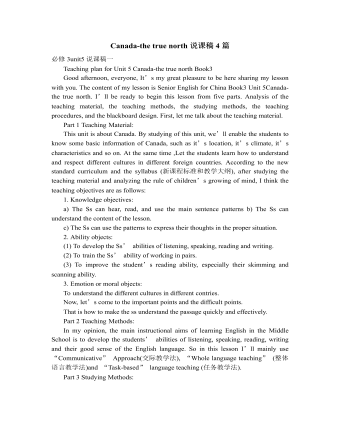
人教版高中英语必修3Canada-the true north说课稿4篇
Good afternoon, teachers, It’s my great pleasure to be here sharing my lesson with you.The content of my lesson is Senior English Book 3 Unit 5 Canada —— “The true North”.I’ll be ready to begin this lesson from five parts. Analysis of the teaching material,the teaching methods,the studying methods, the teaching procedure,and Blackboard design.First, let me talk about the teaching material.Part 1 Teaching Material:This unit is about the introduction of Canada. By studying of this unit,we’ll enable the students to learn the geography, population, main cities, and natural beauty, natural resources of Canada. Through the training of the unit, it also requires students to learn some Language skills such as the expressions of position and emotions.So it plays an important part in the English teaching in this book.After studying the teaching material and analyzing the rule of children’s growing of mind,I think the teaching aims are the followings:1.Knowledge objects:(1) make the students learn some new words and phrases(2) make the students understand the content of the lesson.2.Ability objects:(1)To develop the Ss’ abilities of listening, speaking, reading and writing. Especially reading and speaking ability.(2) learn to talk about the characters of Canada in English(3)To train the Ss’ ability of working in pairs.3.Emotion objects:(1)Enable students to understand the characters of Canada..(2)Stimulate Ss to work hard to make China stronger.Part 2 Teaching Methods:I think helping students learn to master new words and phrases and improve the students’ reading and speaking ability is import and the difficult.According to the analysis of the teaching material and the import points and the difficult points,I will use the following teaching methods : question-guiding approach; fast-reading and careful reading; multi-media teaching methods; discussion
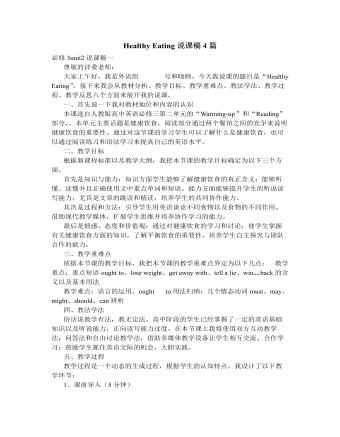
人教版高中英语必修3Healthy Eating说课稿4篇
Language learning needs a context, which can help the learners to understand the language and then can product comprehensible output, so computer has the advantages to make the materials attractive.Part 3 Learning MethodsTask-based, self-dependent and cooperative learningPart 4 Teaching ProcedureStep One Lead-in“Interest is the best teacher.” Therefore, at the very beginning of the class, I should spark the students’ mind to focus on the centre topic “the band”. I’ll show some pictures of food to attract their attention and then bring some questions.Question:What kind of food they like?What should go into a good meal?The answers must relate to the diet. After this, the students will be eager to know something about a balance diet and this is the very time to naturally lead the class into Step 2Step 2 Reading for information: skimming and scanning In this step, I use Task-based Language Teaching method, which can give students a clear and specific purpose while skimming and scanning the context.Task 1 General ideaThe students will be asked to just glance at the title and the pictures of the passage, and then guess what they will read in the text. And they’ll be divided into groups of four to have a discussion.The purpose is to inspire the students to read actively, not passively. In addition, the task is to develop the students’ reading skill by making prediction and to encourage the students to express their thoughts in English and cooperate with each other.Task 2 Main idea of each paragraphCooperative learning can raise the students’ interest and create an atmosphere of achievement. Based on this theory, I divide the whole class into 4 groups to skim the whole text and get the main idea of each paragraph.
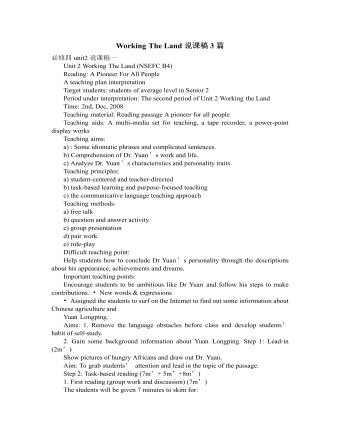
人教版高中英语必修4Working The Land说课稿3篇
Knowledge objectives:(1) to make Ss grasp the usage of words, expressions and sentence structures: statistics, struggle, thanks to, rid of, some patterns for persuasion, the “ing” form as subject and object;(2)to use learnt knowledge to persuade sb.Ability objectives:(1) to develop Ss’ reading skills(skimming, scanning, word guessing);(2) to improve Ss’ speaking, communicating and cooperating skills.Emotional objectives:to make Ss know the contribution of Yuan,and learn his spirit and his simple life time.Teaching important and difficult points:(1) some words, expressions and sentence structures mentioned above;(2)the content of the text;(3)training their reading and speaking skills.Teaching methods: CLT, TBLT,QT.Learning strategies: CLS, QLS, TBLS.Teaching procedures:Step 1 lead-in: (1) teacher plays a piece of recent news from CCTV about the harvest of the super hybrid rice, and ask students whether they know Yuan or not, and talk about him and his contribution.(2)Brain storm: let Ss describe Yuan in their minds including his appearance, his living condition and so on.Step 2 fast reading tasks:(1)teacher introduces Yuan and super hybrid rice(2)make Ss read the text as fast as possible with questions. Such as: what’s the general ideaof this passage? What’s Yuan’ dream? (skimming and scanning skill)Step 3 intensive reading tasks(1)let Ss read the text silently, find topic sentence of each paragraph and draw the difficult sentences and the knowledge what they don’t understand.(words guessing)(2)teacher and Ss talk about the important words, expressions and sentences together, and ask Ss to retell the content of the text.(summarizing and paraphrasing)(3)teacher summarize this part.(4) read again following the courseware.
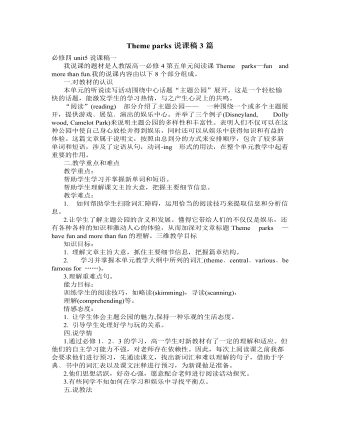
人教版高中英语必修4Theme parks说课稿3篇
The oldest and the most popular park in the worldenjoy the exciting activities thereget close to the life-size cartoon characters like Mickey Mouse and Donald Duck Step 3 Pre-reading1.What do you suppose a theme park is ?2.What do you think you can see in a theme park?(1.It is a kind of amusement park which has a certain theme – that the whole park is based on. 2.buildings, castles, statues, rare animals and birds, and so on.) Step 4 Reading ----- Theme Parks –---- Fun and More Than Fun1.Predict : Read the title and the pictures on P. 34 and PredictWhat is the meaning of the title “Theme Park – Fun and more than fun”?(The title means that theme parks are fun to visit, but that they can also be educational and can offer useful information.)2.Skimming Fast read and answer:What activities can we take in a theme park?Amusement park: Bumper car Merry-go-round slide bungee jumping Free-fall rides Horror films Pirate ship Ferris wheel roller coaster3.Scanning Read again and you will find various theme parks are mentioned in the passage . Then what are they ?Theme parks: Sports theme park History theme park Culture theme park Marine or Ocean theme Park Future park Science theme park Disneyland4.Careful reading and find the main idea of each paragraph:THEME PARKS---- entertaining/ educationalPara.1 Traditional parks are places to go for relaxation and to have time away from our busy lives.Para.2 Theme parks are different They’re large and full of things to do, see and buy.Para.3 Theme parks are built around a single idea or theme. One example is a sports park.Para.4 Another kind of theme park is historical more and cultural and can be educational.Para.5 Disneylandwas the first theme park. It is based on the fantasy life and characters of Disney’s films.Para.6 Some examples of educational theme parks include sea world parks and science parks.
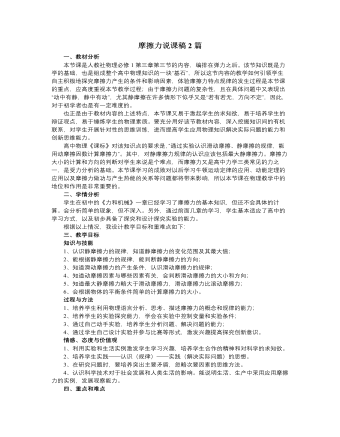
人教版新课标高中物理必修1摩擦力说课稿2篇
本节课是人教社物理必修1第三章第三节的内容,编排在弹力之后。该节知识既是力学的基础,也是组成整个高中物理知识的一块“基石”,所以这节内容的教学如何引领学生自主积极地探究摩擦力产生的条件和影响因素,体验摩擦力特点规律的发生过程是本节课的重点,应高度重视本节教学过程;由于摩擦力问题的复杂性,且在具体问题中又表现出“动中有静,静中有动”,尤其静摩擦在许多情形下似乎又是“若有若无,方向不定”,因此,对于初学者也是有一定难度的。也正是由于教材内容的上述特点,本节课又易于激起学生的求知欲,易于培养学生的辩证观点,易于锤炼学生的物理素质。要充分用好该节教材内容,深入挖掘知识间的有机联系,对学生开展针对性的思维训练,进而提高学生应用物理知识解决实际问题的能力和创新思维能力。高中物理《课标》对该知识点的要求是,“通过实验认识滑动摩擦、静摩擦的规律,能用动摩擦因数计算摩擦力”。其中,对静摩擦力规律的认识应该包括最大静摩擦力。
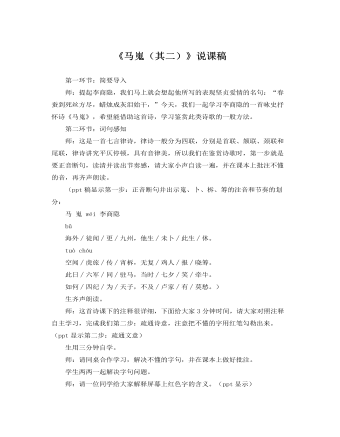
人教版高中语文必修3《马嵬(其二)》说课稿
生2:颔联的意思是只听到禁卫军中传来夜间巡逻的梆子声,不再向宫中那样安逸地听到有鸡人打鸣报时的声音了。生3:颈联的意思是说事变发生那天军队发生哗变停留不前,但当年唐玄宗以为自己可以和贵妃天天在一起,对天上的牵牛和织女一年一度的会见还加以嘲笑呢。生4:尾联的含义是为什么唐玄宗当了四十五年的皇帝,还不如普通百姓夫妻恩爱,长相厮守。师:好的。请大家再齐读一遍诗文,做到人人都能疏通诗的含义。学生再次齐读。第三环节:专项探究师:白居易曾说:“文章合为时而著,歌诗合为事而作。”这首诗就是作者途经马嵬驿,咏马嵬之变这一历史事件而作,所以我们鉴赏的第三步,就是通过标题和诗文,弄清诗中的历史事件。请同学们找出诗中哪些诗句描述了这一事件?
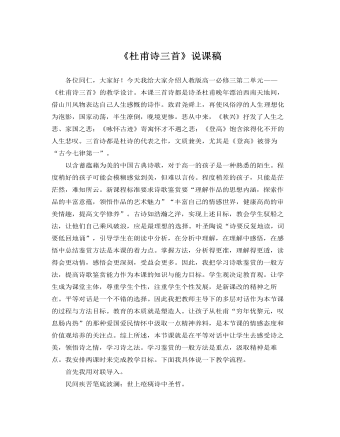
人教版高中语文必修3《杜甫诗三首》说课稿
我以以《登高》为例,引导学生进行意象分析,感悟意境美。古人云“立象以尽意”“古诗之妙,专求意象”意象是诗人情感的载体,是诗歌的灵魂。引导学生张开联想和想象的翅膀去感受,去体验是意象,诗歌鉴赏的关键。科林伍德说“真正艺术的作品,不是看见的,也不是听到的,而是想象中的某种东西。”诗人通过想象创造出诗的形象,我们读者通过想象丰富地再现诗人创造的形象。而感受体验则是以全部身心投入作品,心灵与心灵相沟通,感情与感情相交流,对诗人的想象活动进行再经历和再体验。因此,在引导意象解读中,我先让学生点击这一个,就是通过抓修饰词、依据感情基调、展开想象具体分析本诗中每个意象的情感意蕴和审美意蕴,使学生明白意象在每首诗中的独特性。
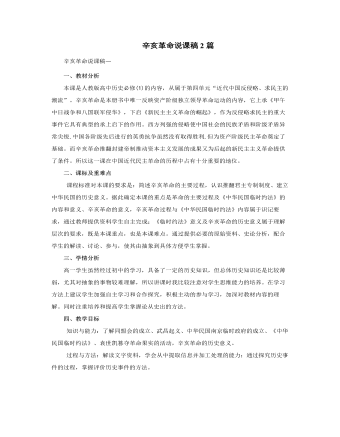
人教版高中历史必修1辛亥革命说课稿2篇
三、辛亥革命的结局1.袁世凯窃取革命果实由课件给出窃取革命果实的简单过程,帮学生理清思路,创设问题情境,由学生分析革命果实被窃取的原因,教师给以补充并揭示根本原因,贯穿整个革命的资产阶级的软弱性和妥协性,再次加深对难点的理解。2.历史功绩辛亥革命性质、功绩由学生阅读书本进行总结,再加以补充让学生在书本上做好记录,强调最大功绩是结束了两千多年的君主专制政体。辛亥革命的失败及其评价很易搞成生硬的一言堂形式,可以从多种角度把学生思维调动起来。这里采用列举一个合作探究,自由讨论的题目“有人认为辛亥革命因为没有完成反帝反封建的革命任务而失败,有人则认为辛亥革命是中国“从君主到民主”社会转型的成功开始。你同意哪种看法?”要求同学们自由讨论.各抒己见,大胆创新,言之在理即可.教师在一旁引导学生,活跃课堂气氛.最后教者归纳总结学习历史从不同的角度看问题可以得出不同的结论,学会用辩证的观点看待历史问题,对辛亥革命有个全面的认识。
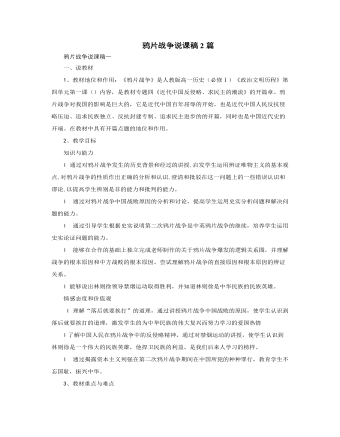
人教版高中历史必修1鸦片战争说课稿2篇
“第二次鸦片战争”爆发的原因的讲析,可通过出示英国在鸦片战争后在中国与洪都拉斯的正当贸易对比表,让学生观察和创设情景来得出结论。战争的经过及影响,可以通过两次鸦片战争形势图,以及一张相关的表格,从战争的根本目的、性质、过程及影响等方面来比较两次战争的异同,从而让学生理解掌握“战火再燃”其实就是中英鸦片战争的继续和扩大。并理解“第二次鸦片战争”的如何使中国社会半殖民地半封建化的程度大大加深了。并突出英法两国殖民者在占领北京期间所犯的滔天罪行。3、结:结合板书设计,让生自己总结这节课所学的内容,并通过课后习题练于讲相结合,来巩固本课知识。在此基础上对本课线索及主要知识点进行简要的梳理。4、课题延伸:教材后探究学习总结中的一段材料,即《英国驻华商务监督义律致英国外交大臣巴麦尊的机密件》,让学生究义律对中国发动鸦片战争原因的说辞来展开探讨,启发学生运用辨证唯物主义的基本观点,澄清和批驳在在一问题上的一些错误和谬论,从而提高学生辨别是非的能力和批判的能力.
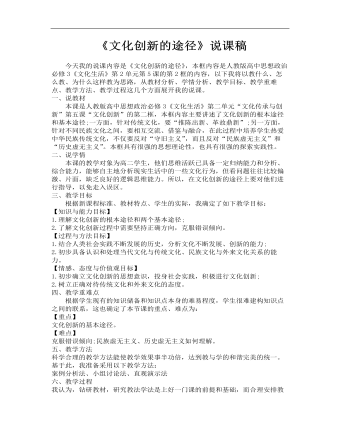
高中思想政治人教版必修三《文化创新的途径》说课稿
二、说学情本课的教学对象为高二学生,他们思维活跃已具备一定归纳能力和分析、综合能力,能够自主地分析现实生活中的一些文化行为,但看问题往往比较偏激、片面,缺乏良好的逻辑思维能力。所以,在文化创新的途径上要对他们进行指导,以免走入误区。三、教学目标根据新课程标准、教材特点、学生的实际,我确定了如下教学目标:【知识与能力目标】1.理解文化创新的根本途径和两个基本途径;2.了解文化创新过程中需要坚持正确方向,克服错误倾向。
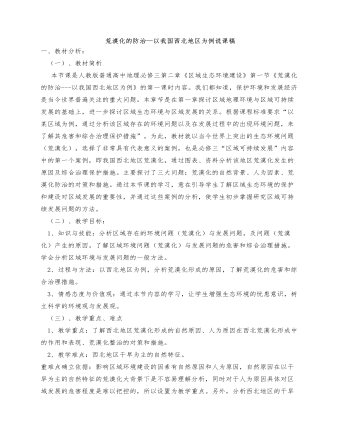
人教版高中地理必修3荒漠化的防治—以我国西北地区为例说课稿
(设计意图: 通过这两个问题探究的形式可以了解学生对二、干旱为主的自然特征这一知识点的掌握情况,随堂练习有利于巩固强化学生的条例性知识。)三、荒漠化的成因1、自然因素:干旱、气候异常2、人为因素:(是荒漠化发生、发展的决定因素)自然原因启发学生利用已经学过的知识(干旱为主的自然特征)和给出的PPT资料来进行分析。人为原因以其危害结果用图表和图片的形式展示,使学生认识到人为因素是导致荒漠化最主要的因素。(设计意图:通过分析自然因素提供学生分析一区域环境建设的自然基础条件,而这也是较难的一点,再者,通过分析人为原因,是学生树立区域生态环境保护意识。)四、布置作业:书本课本20—22的活动—— 非洲萨赫勒地区荒漠化的自然、社会经济

人教版新课标高中物理必修2探究功与速度变化的关系说课稿2篇
共享实验收集的信息,分享实验探究的结论,体验收获的乐趣。 小结拓展 这节课由大家感兴趣的球类运动和弹弓游戏,提出了功与速度变化关系的问题,利用倍增思想解决测量对物体做功的问题,使用我们熟悉的器材设计了探究方案,并进行实验探究,采用图像法进行数据处理,初步得出W∝V2的关系。在我们这节课探究以前,科学家就通过试验和理论的方法,已经总结出了功与速度变化的定量关系。人类社会也在社会生活和生产的各个领域予以利用。比如,古代的战争武器抛石器、大型弓弩,以及现代飞机弹射系统、还有机器人行走等等,希望同学在今后的学习中注意留心生活中的物理和社会中的物理。 领会总结。培养概括总结的能力,进一步巩固、感悟、提升实验探究中获得的思维能力及动手能力。感悟社会中的物理,认识物理学对科技进步以及文化和社会发展的影响。 列举学生知道的社会中做功使物体速度变化的例子,增强学生将物理知识应用于生活和生产的意识,培养学生的社会参与意识和对社会负责任的态度。
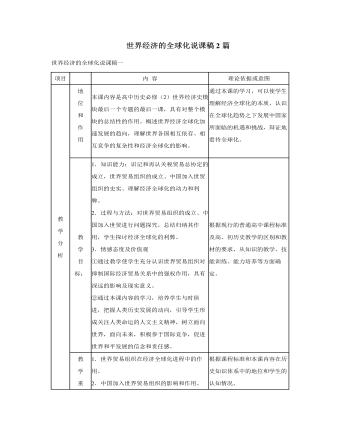
人教版高中历史必修2世界经济的全球化说课稿2篇
【合作探索】经济全球化和经济区域集团化的关系?相互促进,相互制约。促进:经济全球化不平衡导致经济区域集团化,区域集团化是经济全球化的具体表现,经济区域集团化是最终实现经济全球化的重要步骤和途径,经济全球化则是区域经济集团化的最终归宿。制约:但经济区域集团化短期内对全球化不利。过渡:经济全球化让世界得以发展,但也有不公平的因素,那么,谁来维护公平了?二 、世界贸易组织的建立师:世界贸易组织建立的主要原因是什么?生:⑴经济全球化的发展迅速;⑵关贸总协定存在许多弊端,不适应经济全球化发展的要求师:它是怎样建立起来的?生:①1986年: 意大利 提出倡议②1993年:乌拉圭回合谈判——把多边贸易组织改名为世界贸易组织③1994年: 正式决定建立WTO④1995.1.1:WTO正式开始运作师:世贸组织特点是什么?宗旨是什么?生:规范化 法制化。促进各国市场开放,调解贸易纠纷,实现全球范围内的贸易自由化
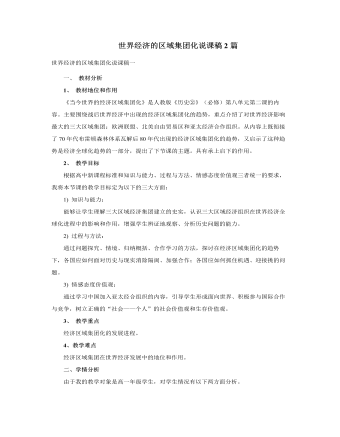
人教版高中历史必修2世界经济的区域集团化说课稿2篇
一、 教材分析1、 教材地位和作用《当今世界的经济区域集团化》是人教版《历史②》(必修)第八单元第二课的内容。主要围绕战后世界经济中出现的经济区域集团化的趋势,重点介绍了对世界经济影响最大的三大区域集团:欧洲联盟、北美自由贸易区和亚太经济合作组织。从内容上既衔接了70年代布雷顿森林体系瓦解后80年代出现的经济区域集团化的趋势,又启示了这种趋势是经济全球化趋势的一部分,提出了下节课的主题。具有承上启下的作用。2、 教学目标根据高中新课程标准和知识与能力、过程与方法、情感态度价值观三者统一的要求,我将本节课的教学目标定为以下的三大方面:1) 知识与能力:能够让学生理解三大区域经济集团建立的史实,认识三大区域经济组织在世界经济全球化进程中的影响和作用,增强学生辨证地观察、分析历史问题的能力。
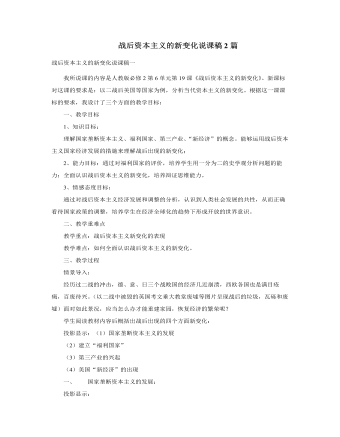
人教版高中历史必修2战后资本主义的新变化说课稿2篇
2.“里根经济学”和“撒切尔主义”20世纪70年代,世界资本主义经济发展进入“滞胀”状态后,各国政府纷纷寻找医治这一新疾病的药方,其中影响最大的是供应学派和货币学派。1979年,撒切尔夫人上台担任英国首相,率先采纳了货币学派的主张。1981年,里根担任美国总统后,以供应学派为依据,确立了自己政府的经济政策。由于两人的经济政策都在一定程度上缓解了本国的经济危机,并有一套理论体系支撑,因此经济学家们分别称之为“里根经济学”和“撒切尔主义”。实际上,“里根经济学”和“撒切尔主义”有许多相同之处,二者都提倡自由放任,强调市场调节作用,反对国家干预;二者都实行有利于富人的减税政策,因此都曾被攻击为“劫贫济富”;二者都大力增加军费开支,用加大政府消费来缓解危机。3.美国“新经济”战后西方国家在凯恩斯主义指导下,暂时摆脱了三十年代那种严重的大萧条局面,但由于长期实行扩张性财政货币政策和对社会需求进行管理的政策,各资本主义国家经济又出现新的危机,即“滞胀”(生产停滞和通货膨胀),凯恩斯主义由此走向没落。
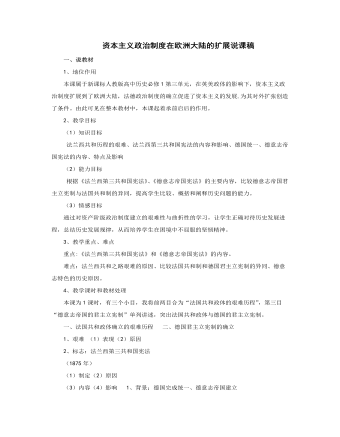
人教版高中历史必修1资本主义政治制度在欧洲大陆的扩展说课稿
1789年法国大革命后,共和派与君主派之间进行了长期反复的斗争,直到1875年法兰西第三共和国宪法通过才最终确立了共和政体,它为法国资本主义的进一步发展奠定了基础。专制色彩浓厚的普鲁士通过王朝战争这种自上而下的形式,完成了德国的统一。1871年德意志帝国宪法颁布,德国君主立宪政体确立,保留了浓厚的专制残余和军国主义传统。但资产阶级代议制的建立使德国的资本主义工业迅速发展起来,19世纪末跻身到世界强国行列。资本主义政治制度扩展到了欧洲大陆,随着这两个国家资本主义政治制度的确立,近代西方主要资本主义政治制度得以最终确立。四、板书一、法国共和政体确立的艰难历程1、艰难 (1)表现 (2)原因2、确立标志:法兰西第三共和国宪法
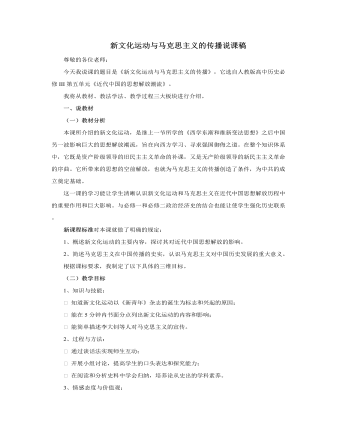
人教版高中历史必修3新文化运动与马克思主义的传播说课稿
一、说教材(一)教材分析本课所介绍的新文化运动,是继上一节所学的《西学东渐和维新变法思想》之后中国另一波影响巨大的思想解放潮流,旨在向西方学习、寻求强国御侮之道。在整个知识体系中,它既是资产阶级领导的旧民主主义革命的补课,又是无产阶级领导的新民主主义革命的序曲。它所带来的思想的空前解放,也就为马克思主义的传播创造了条件,为中共的成立奠定基础。这一课的学习能让学生清晰认识新文化运动和马克思主义在近代中国思想解放历程中的重要作用和巨大影响。与必修一和必修二政治经济史的结合也能让使学生强化历史联系。新课程标准对本课就做了明确的规定:1、概述新文化运动的主要内容,探讨其对近代中国思想解放的影响。2、简述马克思主义在中国传播的史实,认识马克思主义对中国历史发展的重大意义。根据课标要求,我制定了以下具体的三维目标。

人教版高中历史必修1世界多极化趋势的出现说课稿2篇
(一)本课教材地位分析本课教材的主题是世界格局多极化趋势的出现,在整个单元中有承前启后的作用,前一课是它的大背景,后一课是它的延续。本课的核心问题是两极格局下,20世纪六七十年代世界多极化趋势的出现。通过走向联合的欧洲、迅速崛起的日本、发展中国家的星期以及中国的崛起三方面内容,反映了世界格局多极化趋势的出现。在教学中,应注意利用学生对时事的关心与熟悉,引导学生进行相应的探究活动,使学生对世界格局的发展变化能够认识准确和完整把握。(二)三维目标A.知识与能力1.通过对欧洲一体化的进程、日本经济迅速崛起、不结盟运动和中国振兴的基本史实的学习,掌握20世纪六七十年代世界多极化趋势出现的史实,理解其世界大背景和“多极化”的概念。2.通过西欧、日本、中国的崛起,理解经济决定政治,政治反作用于经济。
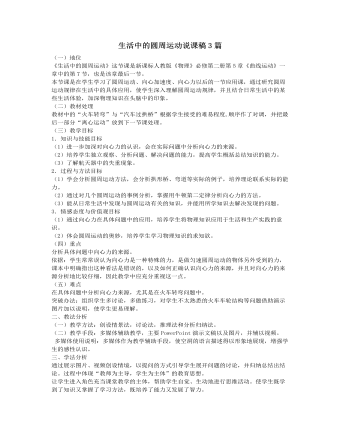
人教版新课标高中物理必修2生活中的圆周运动说课稿3篇
(一)地位《生活中的圆周运动》这节课是新课标人教版《物理》必修第二册第5章《曲线运动》一章中的第7节,也是该章最后一节。本节课是在学生学习了圆周运动、向心加速度、向心力以后的一节应用课,通过研究圆周运动规律在生活中的具体应用,使学生深入理解圆周运动规律,并且结合日常生活中的某些生活体验,加深物理知识在头脑中的印象。(二)教材处理教材中的“火车转弯”与“汽车过拱桥”根据学生接受的难易程度,顺序作了对调,并把最后一部分“离心运动”放到下一节课处理。(三)教学目标1.知识与技能目标(1)进一步加深对向心力的认识,会在实际问题中分析向心力的来源。(2)培养学生独立观察、分析问题、解决问题的能力,提高学生概括总结知识的能力。(3)了解航天器中的失重现象。2.过程与方法目标(1)学会分析圆周运动方法,会分析拱形桥、弯道等实际的例子,培养理论联系实际的能力。
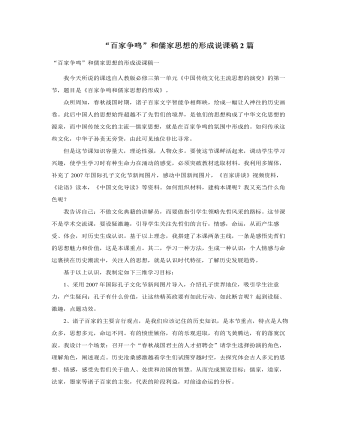
人教版高中历史必修3“百家争鸣”和儒家思想的形成说课稿2篇
我们知道事物之间的矛盾会发生转化。但是,由于老子看不到转化的条件,更看不到人的主观能动性,因此他对人类社会的发展抱着消极悲观的态度,幻想回到“鸡犬之声相闻,老死不相往来”的“小国寡民”的社会。他的思想,通过《老子》一书留传了下来。后来的庄子继承了老子的思想,把“道”作为世界最高的原则,我们可以来看发生在庄子身上的一个故事:庄子在妻子死后,居然鼓盆而歌,朋友惠施去探望时责备他,他讲出一番道理:“当我妻子刚死的时候,我怎么会不难过?可是我省思之后,觉察到她不但没有生命,而且没有形体;不但没有形体,也没有气,然后在恍恍惚惚的情况下,变出了气,气再变化而出现形体,形体再变化而出现生命,现在又变化而回到死亡,这就好像春夏秋冬四季的运行一样。这个人已经安静地睡在天地的大屋里,而我还跟在一旁哭哭啼啼。我以为这样是不明白生命的道理,所以才停止哭泣啊!”





















